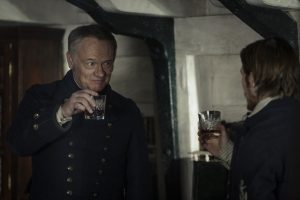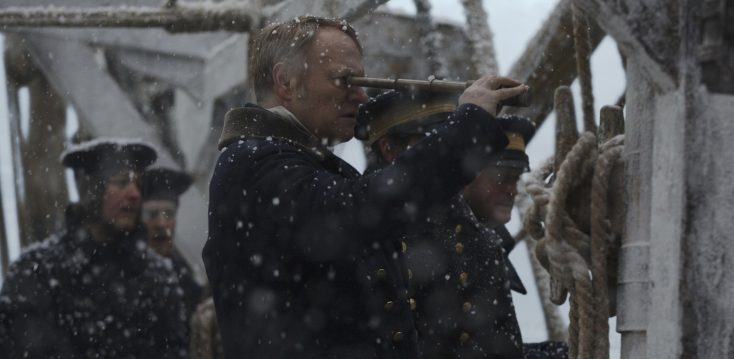
(l-r) Jared Harris as Francis Crozier, Adam Nagaitis as Cornelius Hickey in THE TERROR. ©AMC Film Holdings, LLC. CR: Aidan Monaghan/AMC
By ANGELA DAWSON
Front Row Features
HOLLYWOOD—Jared Harris stars in the 10-part series “The Terror,” a 19th century seafaring journey in which two British navy ships try to find the Northwest Passage through the Arctic but that plan goes awry and they become stuck in the ice. The true story—with a scary sci-fi component—premiered Monday on AMC, is based on the bestselling Dan Simmons novel.
Best known for his Emmy nominated performance as British ad executive Lane Pryce on “Mad Men,” Harris depicts real British naval captain Francis Crozier. The British actor (son of actor Richard Harris) spoke alongside the series’ executive producers/writers David Kajganich and Soo Hugh about the action and suspense-filled series at Hollywood’s own historic Mack Sennett Studios. Filmed in Prague, the multi-genre series—it incorporates both historical fact along with a terrifying sea monster—will likely spark viewers’ imaginations as the crew of the Franklin Expedition sets forth on their perilous journey aboard the HMS Terror and the HMS Erebus in 1845. The series airs Mondays on AMC at 9 p.m./8C.
Harris spoke about researching his character, Francis Crozier, captain of the HMS Terror, who sets course on the treacherous voyage still reeling from a broken heart. He plays the second in command to Sir John Franklin, captain of the sister ship, the Erebus, played by Ciaran Hinds.
Q: How closely did you want to stick to the book?
Kajaganich: With a long form adaptation, you want to do two things at the same time. You want to honor what people love about the book and for people who haven’t read the book, we wanted to give the experience in the show of what it felt like to read that book because it’s a fantastic adventure. At the same time, you want to mix things up. You want to subvert things. Our thematic take is close to Dan Simmons, but we flipped certain things and emphasized others, like characters that are very small parts of the narrative of the book are bigger in our show. We have other characters who are bigger in the book and are sort of reduced in the show. It’s meant to give a surprising experience of watching it as it is to read the book.
Hugh: Dan (Simmons, the author) gave us his greatest gift, which is trust because he knew we weren’t going to be able to tell this story exactly like the book. Fans of the book will be happy with what we kept. The changes we made will feel inevitable to what the story was.
Kajaganich: We also had the benefit of some research that Dan didn’t have when he wrote the book. Since he wrote the book, both ships have been discovered. There have been a number of dives to bring up some archeological artifacts. They know more about where the men ended up so we strived to put a lot of those things in our narrative.
I knew about the Franklin Expedition because we used to talk about these expeditions gone wrong as ways to talk about leadership and preparedness and all those things you take into long expeditions. When I heard that Dan had written this book and crossed it with the gothic horror genre, I couldn’t wait to read it. I was able to get an advance copy and wanted the rights but was a little too late. I’d lost them to Universal Studios. So, I insinuated myself into their process and was hired to write it as a feature film, and then it was a television show for a while, ongoing, and then it was a limited (series). It’s had different lives. AMC, finally, luckily, came to our rescue, and greenlit what you see.
Harris: Remember that time in Prague. Because it has really high winds. They close the bridge to the island sometimes because the winds can be up to 200 mph. One day, we were out filming and it looked like a twister was coming our way. (Kajagnich) went scurrying to the top of a hill to look at it and see what the wind was doing and figure out whether we needed to evacuate.
Kajaganich: One of our tents was lifted off of its moorings and sent spinning into the air. There’s a lot of wind on the show and it’s not all fake.
Q: What was your reaction when the material was presented to you? And what did it take to create this character?
Harris: I got the script and you know, within a couple of pages, whether you’re in the right hands or not. It was incredibly well-written but also had great restraint to it because you understood there were areas where the story was going to go, but they were holding back. For example, Episode Two starts with the cat stalking the rats in the basement of the ship, and that’s also the first time (viewers) encounter the creature. So, it introduces the idea of the predator. But there were really subtle ways they were introducing ideas into the script. It’s fantastic when you read something that well thought-out and that well-handled. It takes a lot of pressure off your mind and you feel in really good hands with storytellers.
As far as the character was concerned, there were three different Croziers: there’s the historical crozier, there’s Dan’s Crozier and there is their Crozier. They’re all the same person but there’s different aspects of the story involved. It was interesting to talk about (with the writers) the historical elements of the character. They took Dan’s character and took what they needed to fit with this story. They negotiated among the narrative needs because it’s their version of Crozier that I had to deliver because they made decisions about the narrative. That’s what the responsibility is: to fulfill that narrative.
One of the most interesting things I read (in doing research) was a letter Crozier had sent to Ross from Disko Bay. He grumbled about not being involved in the fitting out of the ships and being sidelined with the meteorological experiments and only taking interest in (the expedition) as permitted. Mostly, he talks about his disappointment in his life, such as being rejected in his marriage proposal. He says, “oh well, it’s the hurly burly of the seas for me. If that’s all I have left, then that will be it.” You get the sense of this man who had been disappointed in life and this romantic ambition. He really had nothing else. All the reports said you’d never seen a more melancholy Irishman as he set off on this voyage. So, you cherrypick stuff that works for those scenes.
Hugh: We’re so grateful for the research Jared did on Crozier because most of those letters had never been read before. They’d been in storage. The Royal Maritime Museum scanned those letters for us. Watching Jared take notes on those letters and finding out who Crozier could have been from this historical record just made me so grateful.
Kajaganich: Among the many things Jared makes look effortless was reading these letters. The real Francis Crozier had horrible handwriting. I don’t know how he got through them.
Harris: My father had terrible handwriting as well so I had practice. (He laughs.)
Q: How did you build the horror and suspense of the show?
Hugh: We wanted to make sure we respected the subjective view of “The Terror.” Whatever the terrifying view—whether it’s the creature or starvation or the onset of disease—that it comes from the characters’ point of view. We never wanted to jump scare the audience. Our rule was if the characters aren’t scared, the audience shouldn’t be scared. That distinguishes our show from other horror shows.
The creature is an important part of our show. The preferred method for a character to die is the creature because there are so many other horrors they face that are so terrifying. Personally, I’d rather not die of lead poisoning or cannibalism. Once you got into the psychological on set, it was interesting to explore how the genre worked and the language of that.
Kajaganich: As with many senses of humor, there are many senses of horror. We wanted to dip into a lot of them. We said at the beginning we didn’t want a preference for things literary. We wanted to mix things up. We wanted low-brow tools and high-brow tools and mid-brow tools. We wanted to take horror conventions from everywhere and offer the viewer a smorgasbord of different ways of feeling unsettled or frightened or spooked. It’s a lot of fun. Once you open up to wide languages of horror, You get to work out what works for a particular scene instead of just having an attitude about it.
It’s a strange mix of genres. At some points, it’s a horror story. At some points, it’s a high adventure story. There are episodes that we wrote and cut like Westerns. It has the feeling of a war film, at times. We dipped into all kinds of visual grammars.
Harris: (Crozier is) quite a rational man. He’s quite a practical man. They weren’t able to understand what they’re dealing with but your encounter with this creature could have an impact on your through eternity is truly terrifying.
One of the things we talked about there are several departures this character makes. In the third episode, he’s prepared to mutiny to save everybody on the ship. It’s a foolish romantic gesture. He hasn’t let go of the idea that his love affair with Sophia. So, he’s prepared to make this gesture that not only the end of his career but the end of his life.
Kajganich: As writers, this dramatic scenario was such a pleasure to take on because it’s about people in a hierarchy who are being kept from being with one another because of rank, background, gender, class, all those things. This disaster renders those things increasingly irrelevant. The characters are able to put those differences aside and really help one another.
Hugh: This isn’t how humanity turns against one another in the worst of times but about how brotherhood helps one another in the worst of times.





